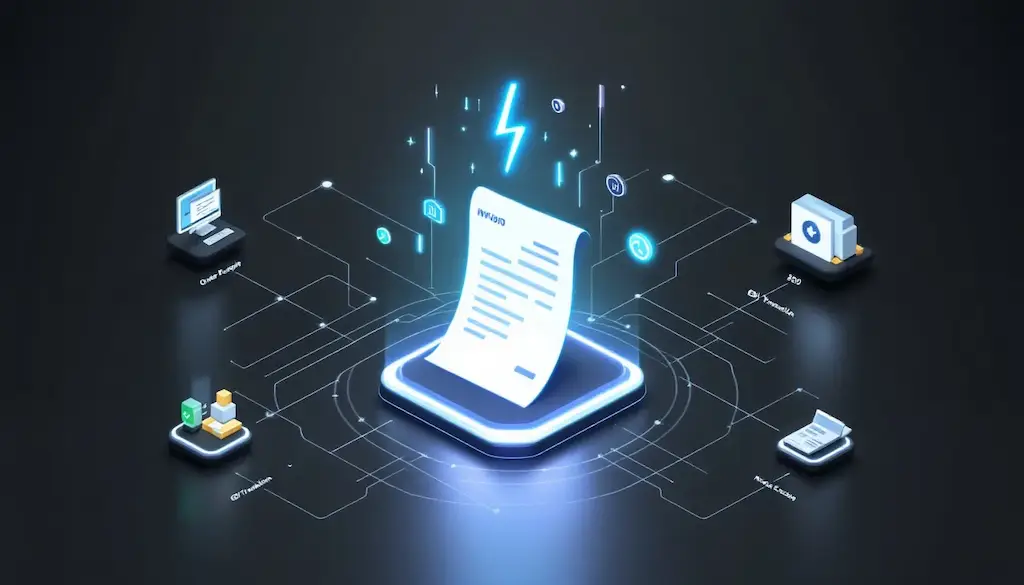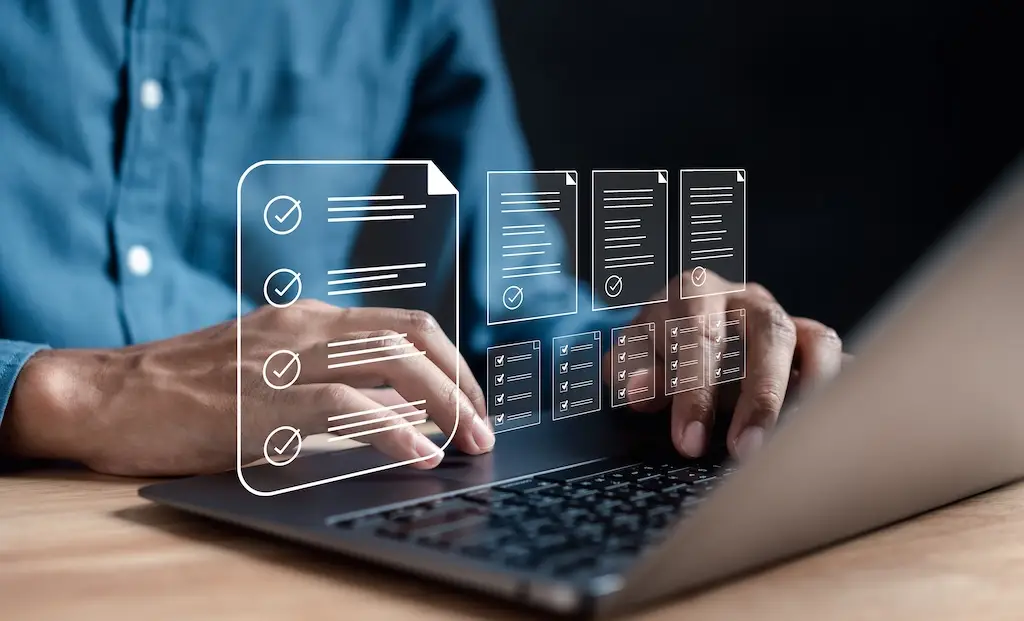An EDI 810 invoice is a digital invoice used to streamline billing in electronic data interchange (EDI). This guide will cover what an EDI 810 invoice is, its key components, benefits like reduced costs and faster payments, and best practices for implementation. You’ll also find insights into troubleshooting common issues and getting started with EDI 810 solutions.
Key Takeaways
- The EDI 810 invoice streamlines the invoicing process by replacing paper invoices with electronic documents, enhancing speed, accuracy, and security in billing transactions.
- Key benefits of EDI 810 invoicing include significant time and cost savings, improved cash flow, and better account reconciliation through automation and standardization.
- Successful implementation of EDI 810 requires adherence to ANSI X12 specifications and the adoption of best practices, including engagement with EDI experts and ensuring integration with existing systems.
Understanding EDI 810 Invoice
The EDI 810 invoice is essentially the digital evolution of the traditional paper invoice. In the realm of electronic data interchange, the EDI 810 invoice facilitates faster processing by eliminating the need for manual data entry and paper-based transactions. Typically sent by the seller after goods have been shipped, it serves to confirm delivery and request payment. This invoice transaction set is instrumental in ensuring timely and accurate billing processes, replacing cumbersome paper-based invoices with streamlined electronic invoicing documents.
Imagine the traditional cycle of invoice transactions—sending out a paper-based invoice, waiting for it to be delivered, hoping it doesn’t get lost, and then waiting for the buyer to process it. Now, envision all of this happening almost instantaneously with an electronic invoice. The EDI 810 invoice not only speeds up this entire process but also enhances accuracy by reducing the chances of human error associated with manual data entry.
The EDI 810 invoice goes beyond just replacing paper invoices; it represents a shift towards a more efficient, reliable, and scalable billing system. Integrating EDI 810 invoices into your business operations means adopting a new approach that prioritizes speed, accuracy, and security.
Key Benefits of EDI 810 Invoicing
One of the most compelling advantages of the EDI 810 invoice is the significant time and cost savings it offers. By automating the invoicing process, businesses can drastically reduce the labor costs associated with manual data entry and the processing of paper invoices. This automation minimizes the chances of human error, ensuring that invoice details are accurate and reducing the need for time-consuming corrections.
Moreover, the structured format of EDI 810 invoices simplifies account reconciliation. This standardized approach not only aids in maintaining accurate financial records but also enhances security compared to traditional EDI document methods. With protocols in place for data protection, businesses can be confident that their invoicing documents are secure.
Rapid processing of EDI 810 invoices also accelerates payment timelines, allowing businesses to access revenue more swiftly. This quicker turnaround can be particularly beneficial in improving cash flow. Additionally, the standardized formats ensure consistency and clarity in billing and payment communications between suppliers and buyers, fostering better business relationships.
Essential Components of an EDI 810 Invoice
An EDI 810 invoice is composed of several critical components that ensure comprehensive and accurate billing. Key among these are the invoice number, date, payment details, and item descriptions. The invoice number and date are crucial for tracking and reference purposes, ensuring that both parties can easily identify and verify the transaction.
The TDS segment (Total Dollar Summary) of the EDI 810 invoice contains the total amount due, providing a clear and concise summary of the billing. Meanwhile, the IT segment holds detailed information about each item, including quantity, unit price, and unit of measurement. This level of detail helps both the seller and buyer to confirm receipt of goods and services accurately.
However, common issues can arise if essential data fields are incomplete or incorrect. Missing currency or date values and incorrect remit-to vendor numbers in the N1 segment can lead to payment delays and billing discrepancies. Ensuring all necessary fields are correctly filled out is vital for the smooth processing of EDI 810 invoices.
How EDI 810 Fits into the EDI Workflow
The EDI 810 invoice plays a pivotal role in a broader EDI workflow. Unlike other EDI invoicing documents that cater to specific transactions, the EDI 810 can be utilized for multiple transaction types. The EDI workflow typically begins with the issuance of an EDI 850 Purchase Order, which initiates the purchasing process.
After the goods have been shipped, the seller sends an EDI 810 invoice to request payment. Upon receiving the invoice, the buyer sends an EDI 997 Functional Acknowledgment to confirm receipt of the EDI 810 invoice. This acknowledgment is crucial for ensuring that the invoice has been received and accepted, facilitating timely payment.
The EDI 810 transaction is integral to efficient communication between trading partners and timely payment processing. Once confirmed by the EDI 997, the invoice is transferred to the accounting or receivables department for payment. This seamless process underscores the importance of the EDI 810 in maintaining smooth business operations and effective financial management.
Common EDI 810 Invoice Segments
Understanding the common segments of an EDI 810 invoice is essential for ensuring accurate and efficient billing. The ISA segment is the starting point, defining sender and receiver information and ensuring transaction security. This segment sets the foundation for the entire transaction.
The ST segment signifies the start of the transaction set and its type, which in this case is 810. Following this, the REF segment provides reference information such as vendor numbers or department codes, crucial for internal tracking and verification. The N1 segment identifies the parties involved, such as the buying or shipping organizations, ensuring that all relevant entities are accounted for.
Payment terms are outlined in the ITD segment, including any discounts based on delivery dates. The IT1 segment details the individual items being billed, including their quantities and product identifiers, providing a granular view of the transaction.
At the end of the invoice, the CTT segment summarizes the total number of line items, while the SE segment marks the end of the transaction set and includes a count of the segments. Finally, the GE and IEA segments indicate the end of a functional group of related transaction sets and the conclusion of the interchange, respectively. These segments ensure that all parts of the transaction are properly closed and accounted for, completing the EDI 810 invoice transaction.
EDI 810 Specifications and Standards
The structure and data requirements of EDI 810 invoices adhere to the ANSI X12 format, regulated by the American National Standards Institute (ANSI). Compliance with these standards is crucial for maintaining the quality and accuracy of electronic invoices. The ANSI X12 EDI 810 specification provides details on the format and data contents. It is structured into segments and data elements.
This standardized format ensures that all necessary information is included and organized in a consistent manner, facilitating efficient processing and communication between trading partners. The ANSI X12 EDI 810 message is designed to replace traditional paper invoices, providing a structured and reliable method for electronic transactions.
Best Practices for Implementing EDI 810
When implementing EDI 810 invoices, businesses should consider engaging with EDI experts who can guide them through the integration steps. These experts can help ensure that the implementation process is smooth and that all necessary components are correctly integrated into the existing systems.
For businesses looking to scale, solutions like Comparatio EDI allow for easily adding new customers, supporting business growth and scalability. Adopting these best practices can help businesses maximize the benefits of EDI 810 invoicing and ensure a successful implementation.
Troubleshooting Common EDI 810 Issues
Despite its many advantages, EDI 810 invoicing can sometimes encounter issues. Common errors include inaccurate or missing data, such as incorrect invoice numbers and billing amounts. These errors can disrupt the processing of invoices and lead to payment delays.
One effective way to minimize these discrepancies is by automating EDI 810 transactions, reducing the likelihood of errors that can occur with manual entry. Additionally, it’s important to ensure that invoices for certain import purchase orders are not transmitted if they are designated for payment via letter of credit.
Getting Started with EDI 810 Solutions
To get started with EDI 810 solutions, businesses can benefit from automating their invoicing processes. This reduces manual tasks and increases operational efficiency. Integrating EDI 810 invoices with accounting software allows for faster invoice matching and quicker payment processing.
Using a secure Value-Added Network (VAN) for transmitting EDI 810 invoices ensures the security and reliability of the transactions. Ensuring that EDI software is compatible with existing systems is also crucial for seamless operation.
Comparatio: Your Trusted Partner for EDI 810 Invoice Solutions
At Comparatio, we specialize in seamless EDI integration, ensuring that your EDI 810 invoice processes are accurate, efficient, and fully automated. Our EDI software solutions help businesses streamline billing operations by eliminating manual data entry, reducing errors, and accelerating payment cycles.
Why Choose Comparatio for EDI 810 Invoicing?
- Seamless Integration – Our EDI 810 solutions integrate effortlessly with your ERP, accounting, and financial systems, ensuring real-time data synchronization.
- Automated Workflows – Reduce human errors and improve processing speed with our fully automated invoicing system.
- Compliance & Security – We ensure that your EDI 810 invoices adhere to ANSI X12 standards while maintaining data integrity and security.
Scalability – Whether you’re a growing business or an enterprise, our EDI solutions adapt to your needs, supporting multiple trading partners and custom business rules. - Expert Support – Our team of EDI specialists provides hands-on assistance, from initial setup to ongoing optimization.
Enhance Your EDI 810 Invoice Workflow with Comparatio
With Comparatio EDI, you can automate invoice generation, validation, and transmissionl , ensuring compliance with your trading partners’ requirements.
Summary
The EDI 810 invoice stands as a testament to the transformative power of electronic data interchange. By replacing traditional paper invoices with standardized, electronic documents, businesses can achieve significant improvements in efficiency, accuracy, and security. The time and cost savings, coupled with accelerated payment timelines, make EDI 810 a compelling choice for modern enterprises.
As we move towards an increasingly digital future, adopting EDI 810 invoicing is not just a technological upgrade; it’s a strategic move that can enhance business relationships and drive growth. Embrace the change, implement best practices, and leverage the resources available to fully realize the benefits of EDI 810.
Ready to optimize your invoicing process? Contact Comparatio today to implement a reliable, scalable, and cost-effective EDI 810 solution tailored to your business needs.
Frequently Asked Questions
What is an EDI 810 invoice?
An EDI 810 invoice is an electronic document that confirms delivery and requests payment for goods shipped, serving as a modern alternative to traditional paper invoices.
What are the benefits of using EDI 810 invoicing?
Using EDI 810 invoicing yields significant time and cost savings while minimizing human error. It also enhances security, simplifies account reconciliation, and accelerates payment timelines.
What are the essential components of an EDI 810 invoice?
The essential components of an EDI 810 invoice include the invoice number, date, payment details, item descriptions, and specific segments such as TDS, IT, and N1. Each of these elements is crucial for ensuring accurate processing and compliance in electronic transactions.
How does the EDI 810 invoice fit into the EDI workflow?
The EDI 810 invoice is a crucial component of the EDI workflow, as it is issued after the shipment of goods, triggering a confirmation via the EDI 997 Functional Acknowledgement from the buyer, which ultimately facilitates payment processing.
What are common issues with EDI 810 invoices and how can they be resolved?
Inaccurate or missing data is a common issue with EDI 810 invoices. This can be effectively resolved by automating EDI transactions to minimize manual entry errors.




